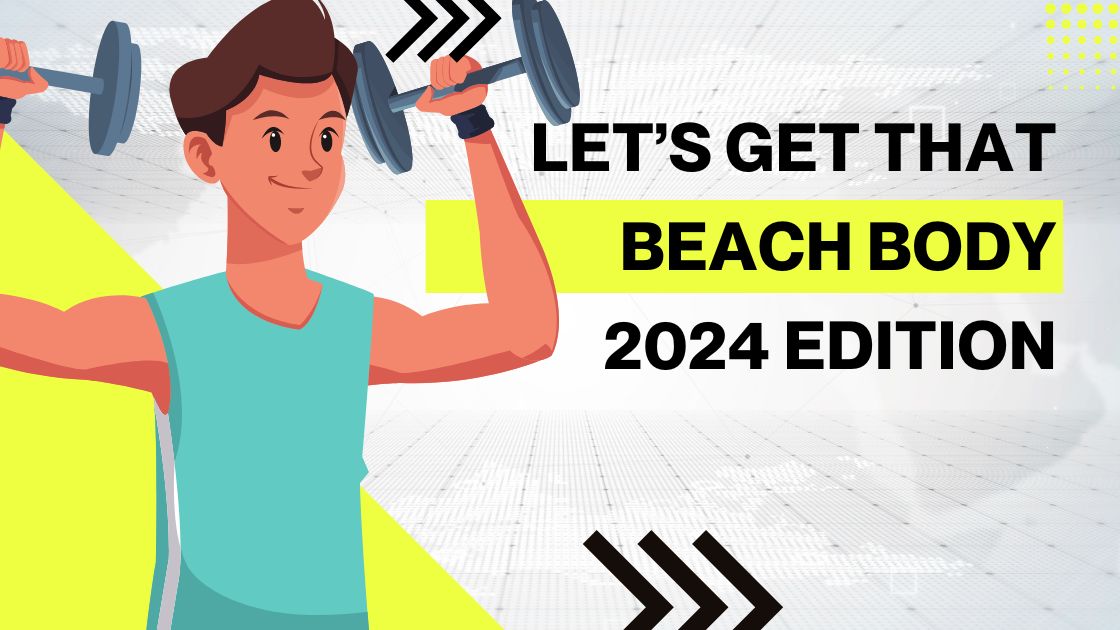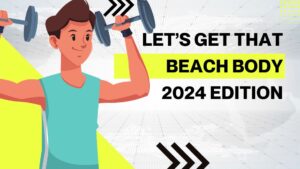Spring and summer are around the corner and that means: more sun, more beach and less clothes. Are you looking to get jacked but are you running in circles where the muscle seems to evaporate as fast as the fat you so hard try to loose? I understand. I’ve been there. Fortunately, there’s a solution. You’ve come to the right place.
Before we get into details, let’s breakdown the meaning of the beachbody.
What is a beachbody?
According to Cambridge dictionary: “a person’s body that is considered attractive enough to be seen on a beach in a swimsuit or swimming trunks”
What does a beachbody look like?
A beachbody obvisouly has some muscle. But nothing too much. All body proportions remain similar to anyone else.
What you’re looking for is to have a couple of elements accentuated:
- Chest: you’re looking to have a nice and rounded chest, mainly the pectoralis major.
- Back: your Latissimus Dorsi create that diverging V-shape
- Shoulders: your lateral deltoids are the cherry-on-top that make accentuate that well sought after V-shape.
- Waist: you can’t be too fatty here as that deaccentuates your V-shape.
- Arms: a common misconseption is that biceps form your armsize, but it’s actually the triceps that constitutes the largest muscle. You’re specifically looking to target the long head of the triceps that form very nicely. Add to that some muscle on the biceps are you’re off for a great physique.
- Legs: yes it’s about the upper body but let’s not forget the lower body. Make sure to target your Rectus Femoris (that nice teardrop shaped muscle in your quad) with leg extensions and your hamstrings to create a well balanced beach body.
The goal of this program
It’s two fold:
- Putting on muscle
- Lowering bodyfat levels
Before we dive in: you should know that a beach body is made in the kitchen. They say that often but it’s true. You can have all the muscle you want, but if they’re hidden behind a neat wall of fat, you won’t get anywhere soon.
If you’re willing to pursue this goal to obtain that beachbody you’ve been chasing after. And if you’re willing to do what it takes to feed your body with the right foods in the right amounts. And if you’re willing to put in this work for somewhere in the range of 4 – 26 weeks, depending on your bodyweight and bodyfat levels, then you’ll succeed.
If not, skip reading, and skip googling ‘beachbody workout’ entirely, because no workout will make up for a crappy diet.
Now, let’s get down to it.
How to train
For every large muscle group (chest, back, legs) do a couple of warm-up sets until you’re near your working set weight.
DO NOT:
- Don’t increase weights every set. Instead, start with a weight so heavy you can barely lift it among 10-16 times.
- Don’t drop the weight quickly. Instead, focus on lowering the weight in a controlled way. No need to count seconds or so, just make sure you lower the weight controllably.
- Don’t go beyond failure. Can’t make a rep? Leave it. Don’t try to push it and failing in the progress.
- Don’t stick to the same weight if you can’t hit the 10-16 reps. Instead, lower the weight. Example: if you can’t make it 10 x 100 anymore, lower the weight to 90 and see if you can hit the 10 reps again.
DO:
- Warm up sets: work your way to the weight you want to train with. Example: if you know you’re squatting about 4 sets of 10 reps x 100 kg, then your warmups could be 6 x 50, 6 x 80 but truly this is all up to you. Whatever you feel comfortable with.
- Lower the weight in a controlled manner. This accentuates the eccentric and that’s where the muscle is made. No need for slow counting or anything that distracts you from the movement. Just make sure you don’t drop the weight fast but rather lower it in a controlled way.
- Train to almost failure (but not failure). Try to estimate how many reps in reserve you still have and try to train close to failure.
- Keep proper form. Cannot keep form? Lower the weight if neccesary.
Start with 12 sets per muscle group per week. No more than 6 sets per muscle group per session. If you don’t see progress, add 4 sets to the muscle group for consecutive weeks.
Exercises to create a beach body
Chest (pectoralis major)
- Bench press
- Dumbell chest press
- Bayesian fly
Back (latissimus dorsi)
- Lat pulldown
- Lat prayer
Arms (biceps)
- Bayesian curls
- Preacher curls
There’s something special about these two exercises. Both the bayesian curl as the preacher curl put tension on your biceps even when you’ve lowered the weight in bottom position. Especially these two curls stimulate stretch mediated hypertrophy. Stretch mediated hypertrophy is likely one of the most important drivers of muscle growth, which is why we’ve included them in the biceps exercises.
Arms (triceps)
- Bench press (barbell)
- Overhead cable tricep extension
Same as with the preacher curl for the biceps, the overhead cable tricep extension puts your triceps under tension even in the bottom position. When you’re into bench pressing, those reps count partially for the tricep count (0,5) so you can take that into account.
Legs (quads)
- Squats (overall winner)
- Unilateral leg extensions (specifically targets the rectus femoris, the teardrop shaped muscle)
If you really wanna rock the beach body look, your legs can’t stay behind. What’s more, the rectus femoris is one of those muscles that actually create that trained look in your quads.
Research has shown that combining low rep heavy sets of squats, followed up with high rep lighter weight sets of leg extensions show above average muscle growth in the quads. So to get the most bang for buck here’s what you can do: do 3 sets of heavy squats (4-6 reps) and afterwards hit that leg extensions machine with 16+ reps of unilateral leg extensions.
Legs (glutes, hamstrings)
- Romanian deadlifts (targets glutes and hamstrings)
Looking to do romanian deadlifts? Here’s how to do them (that’s me in the video)
What about the abs?
You might have noticed that there’s no workouts that specifically target the abs. And the reason is simple. When you train abs, they get bigger. And when they get bigger, your body looks bigger. The thing is, assuming your bodyfat levels are higher than you wished for since you’re reading this article, there’s no need to train the abs specifically. If you get lower in bodyfat levels, your rectus abdominis (or, abs) will appear from underneath the fat.
Nutrition
Like I said, abs are made in the kitchen. You can’t afford to have high bodyfat levels if you wanna appear muscled and toned for that typical surfers or beach body look.
The reason you’ve been burning of muscle at the same or even a faster rate than you’re losing fat is simply because you’ve put your body in starvation mode. Your muscles need nutrition, otherwise your body will metabolize them for energy.
The steps to determining how many kcal you should take:
- Determine your weight
- Determine your bodyfat level
- Determine your basal metabolic rate
- Add a multiplier based on activity level
- Add a multiplier based on food choices
- Add the kcal used for training sessions or exercise
- Sum the total amount of kcal required in a week
- Determine a daily average kcal based on the week total divded by seven
- Subtract the deficit to determine your target kcal intake
The energy balance deficit you’re looking for if you’re a trained individual is about 10-20%. Don’t go higher than 20% as the chances increase that you’ll lose too much muscle.
If you’re quite lean already, err on the safe side and choose 10%. This will make sure you get in enough calories while minimizing the risk that your body will burn muscle for energy.
Macronutrients
- Proteines: bodyweight x 1,8
- Fats: 30% of target kcal intake
- Carbs: remainder of kcals left
This should get you started. Good luck, and make sure to keep me updated on your progress by sending an email or reaching out to me through Linkedin or Instagram!
In case you have more questions on nutrition, I will write another article on nutrition another time. But if you’re a high performing busy person and you are really willing to put in the work for a period of 4 to 26 weeks, just hit me up at bas@basgosewisch.com or find me through Linkedin and I might be able to help you out on a one-to-one basis.




